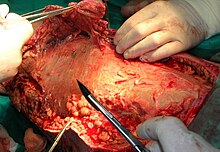Debridement
As debridement or debridement refers to the medical procedure for removal of infected, damaged or dead ( necrotic ) tissue from ulcers, burns and other wounds , particularly chronic wounds , or in organ decay (. Necrotizing e.g., pancreatitis ). The aim is to ensure that the wound is observed, to initiate healing, to prevent secondary infection of the remaining healthy tissue and in this way to stop the infection from progressing, which can lead to sepsis and death.
Methods
Adequate blood flow to the tissue is a prerequisite for the desired wound healing . In some cases, a wound debridement with a sharp instrument will be decided against (for example in the case of a diabetic foot ) if there is a risk of only enlarging the wound without the prospect of healing. In such cases, other debridement methods are available.
Surgical debridement
The surgical method of debridement ( debridement by Friedrich ) is the fastest. The doctor uses surgical instruments such as a scalpel and ring curette to remove dead tissue. This method is preferable if there is a rapidly progressing infection of soft tissues, in which bacteria can enter the patient's bloodstream and there is a risk of sepsis. Larger debridements are usually performed in the operating room under a suitable anesthetic. Usually, the cleaned wound is rinsed with isotonic saline solution during the surgical procedure . Sometimes, for practical reasons, debridement cannot be carried out radically in order not to damage neighboring organs, vessels, nerves or the like. Repeated surgical treatment is often necessary, e.g. B. if necrosis is still progressing after debridement. In the case of osteoarthritis of the knee (wear and tear on the joint with cartilage atrophy), debridement is carried out using arthroscopic surgery . However, it has been shown that the pain relief 2 years after the procedure is no better than after a placebo operation (skin incision only).
Enzymatic debridement
In the past, fruit juices were used on chronic wounds , the proteolytic enzymes of which were supposed to have a debriding effect in the wound. Nowadays, biosynthetically produced enzymes such as clostridiopeptidase or streptokinase are used. The earliest scientific reports on this method date back to the 1960s. For enzymatic debridement, enzymes and other compounds - bound in ointments and gels - are used to dissolve necrotic tissue and tissue debris. This method is more selective than mechanical or surgical debridement, but cannot be used in hard and dry necroses, as enzymes only develop their effect in a moist environment. Known side effects of this debridement method are sometimes painful skin irritation up to wound healing disorders. Enzyme dressings require a daily dressing change and are therefore costly.
Mechanical debridement
With this cleaning method, superficial coverings, tissue remnants and remaining dressing material are picked up with dry or damp compresses and - possibly with the help of tweezers - removed from the wound. In addition to compresses, so-called cleaning cloths or pads specially developed for this purpose as well as special PU foams of different sizes are used. The friction and pressure of such materials on the sensitive areas of the wound area can cause pain in the patient. There is also the risk that the epithelialization will be disturbed or that fresh tissue will be removed.
Autolytic debridement
This is where the body's ability to dissolve dead tissue itself is used. The wound is kept moist for this. Various dressings and dressing techniques can be used. The principle is that the wound secretion itself promotes wound healing with its immune cells, growth factors and enzymes. This form of debridement is the most selective, but it also lasts the longest. The method cannot be used on infected wounds, as most bacteria would thrive in the moist chamber of the dressing.
Biosurgical debridement
- → Main article: Maggot therapy
Using fly larvae grown in a sterile environment , which are either free on the wound or enclosed in a special bag, to thicken the necrosis and coverings and ingest the resulting food pulp.
Ultrasonic debridement
Also known as ultrasound-assisted wound cleaning, it is an efficient form. The wound is rinsed with a rinsing liquid and sonicated with ultrasound . The ultrasonic impulse drives the introduced irrigation fluid into the deeper regions of the wound and loosens plaque and loosely adhering necrosis.
Periodontal debridement
Periodontal debridement is the removal of plaque and concretions from the teeth to treat periodontal inflammation by reducing the pathological bacteria in the mouth and accelerating the healing process in periodontal disease. In this procedure, the tooth and root surfaces are cleaned and polished with curettes (specially shaped hand instruments), with sonic and ultrasound-operated devices or with the use of certain lasers , so that the gums can heal and reattach themselves to the tooth .
literature
- R. Strohal (Ed.): EWMA Document 2013 “Debridement” Status of the development and role of debridement Current overview and definition of terms. In: wound management. mkp-Verlag, Wiesbaden, special issue 3/2013.
- Klaus-Jürgen Bauknecht, Joachim Boese-Landgraf: Wounds, wound healing, wound healing disorders, wound treatment, tetanus prophylaxis. In: Rudolf Häring, Hans Zilch (Hrsg.): Textbook surgery with revision course. (Berlin 1986) 2nd, revised edition. Walter de Gruyter, Berlin / New York 1988, ISBN 3-11-011280-9 , pp. 7-17, here: pp. 14 f .: Wound excisions (debridement) .
Web links
Individual evidence
- ^ B. Moseley et al. a .: A Controlled Trial Of Arthroscopic Surgery for Osteoarthritis of the Knee. In: N Engl J Med. Vol. 347, 2002, pp. 81-88.
- ↑ Kerstin Protz: Modern wound care practical knowledge, standards and documentation, 8th edition, Elsevier Verlag Urban & Fischer, Munich 2016, ISBN 978-3-437-27885-3 , pp. 30–31
